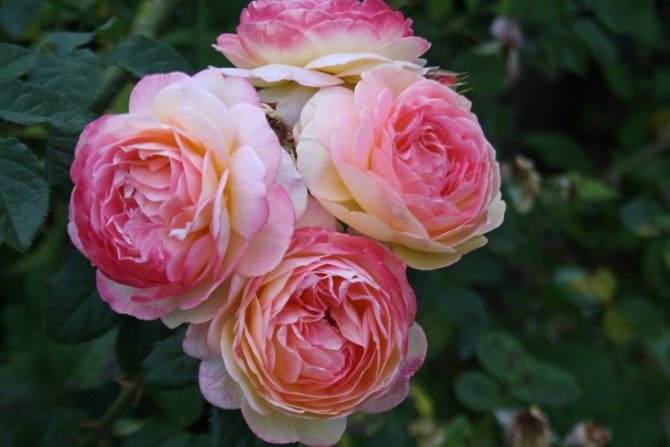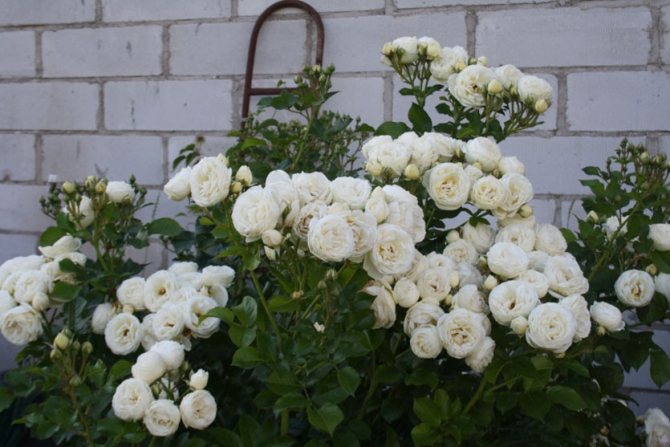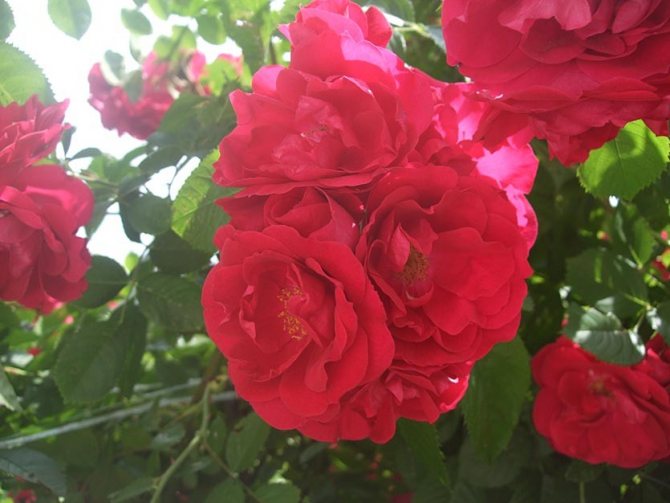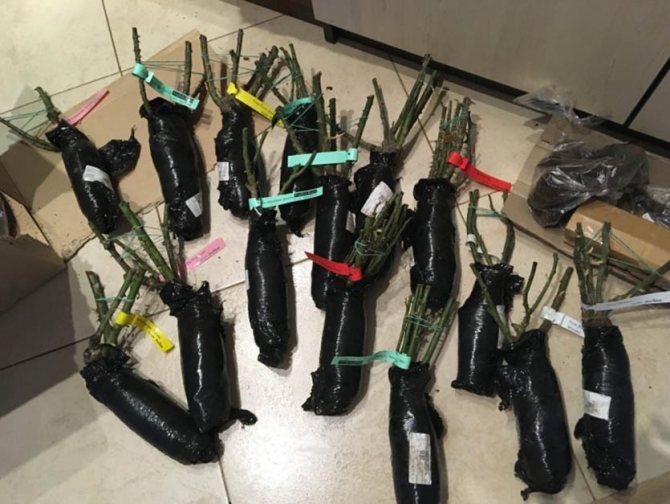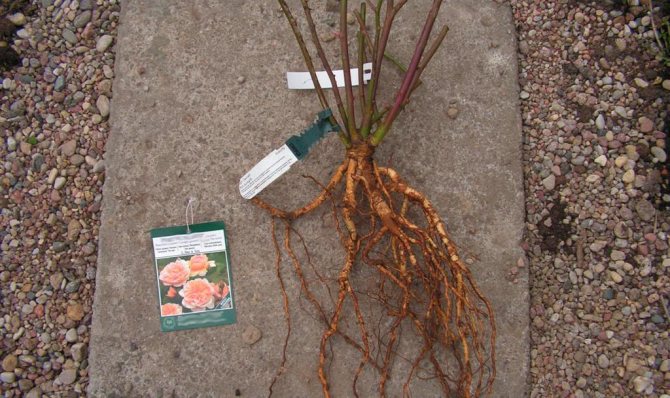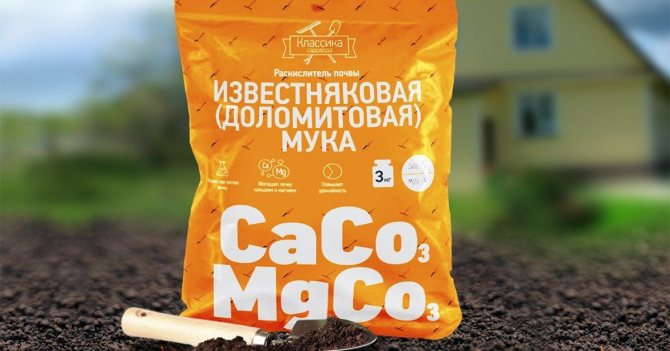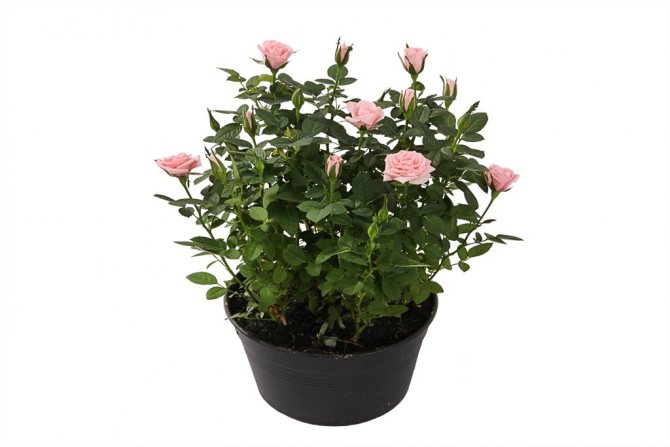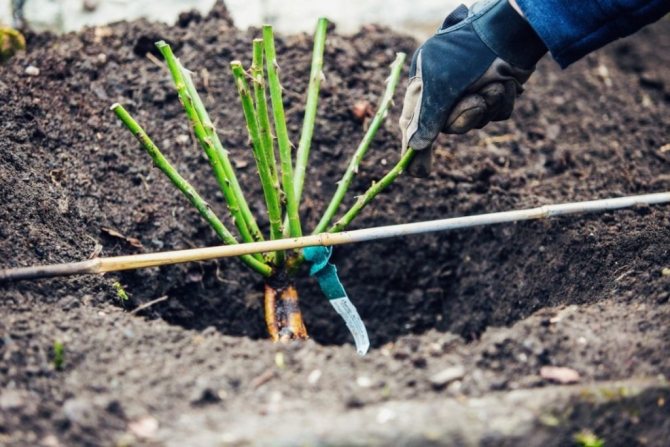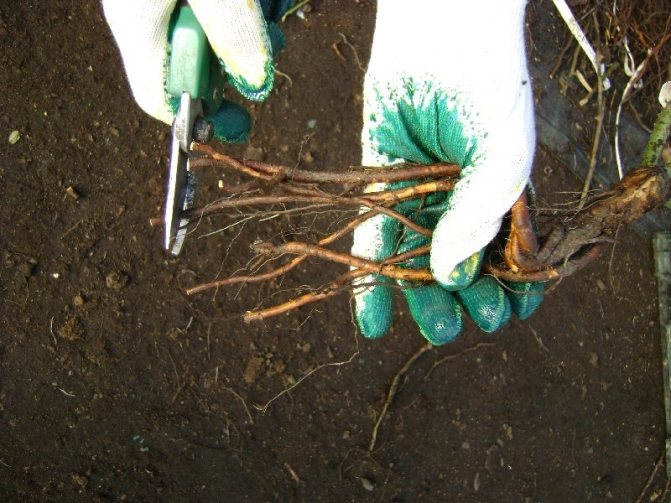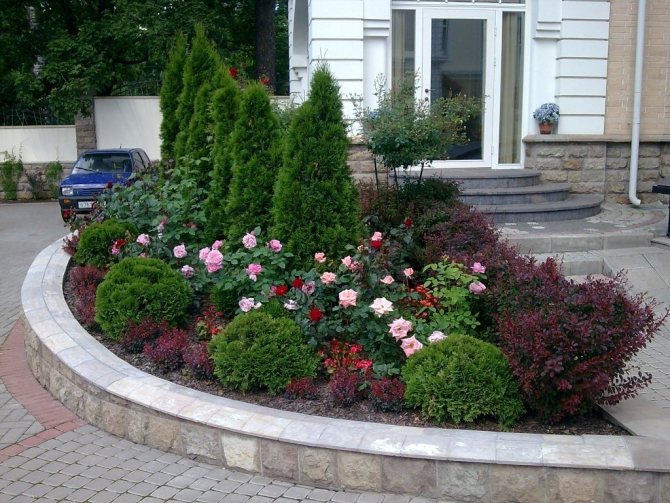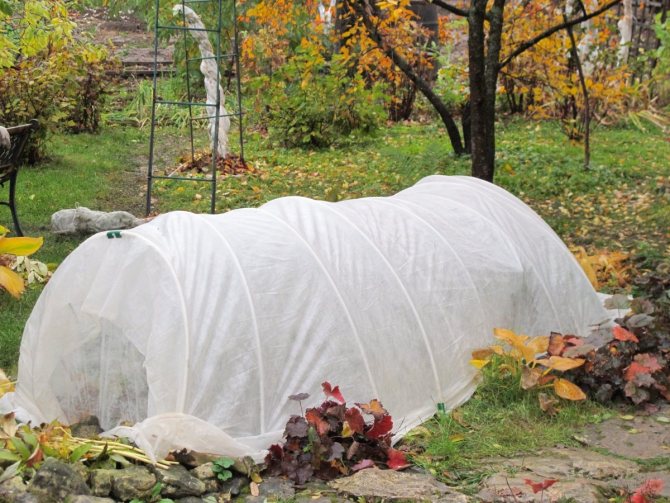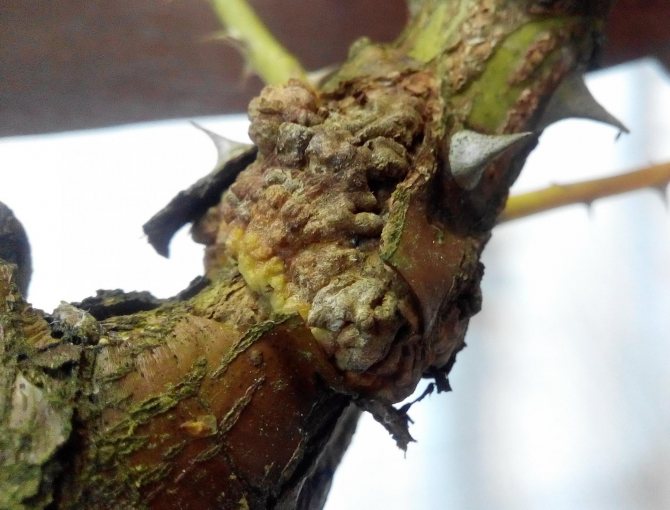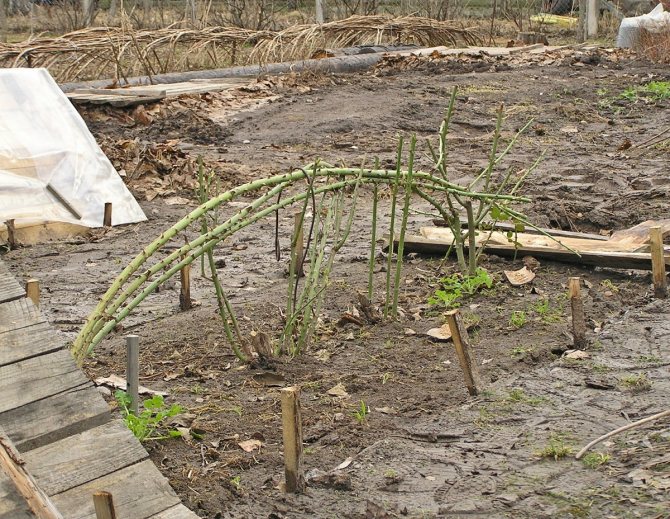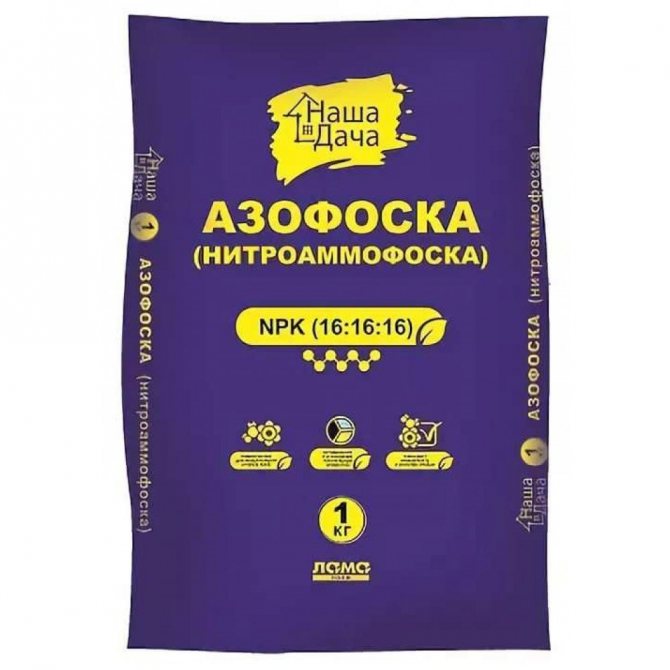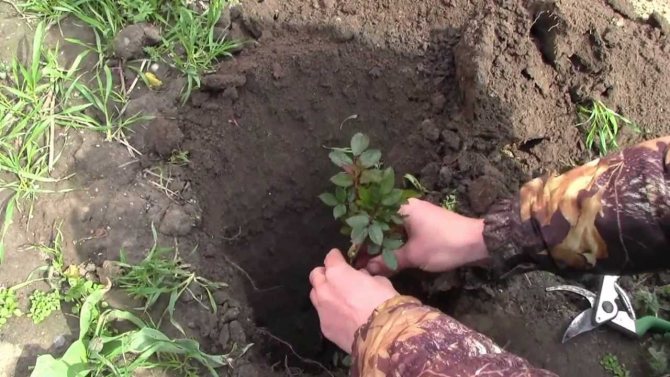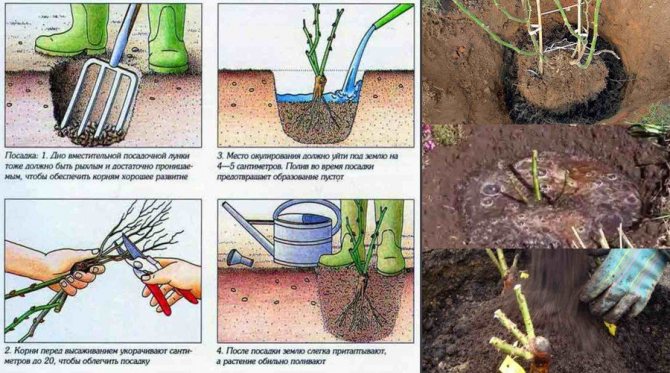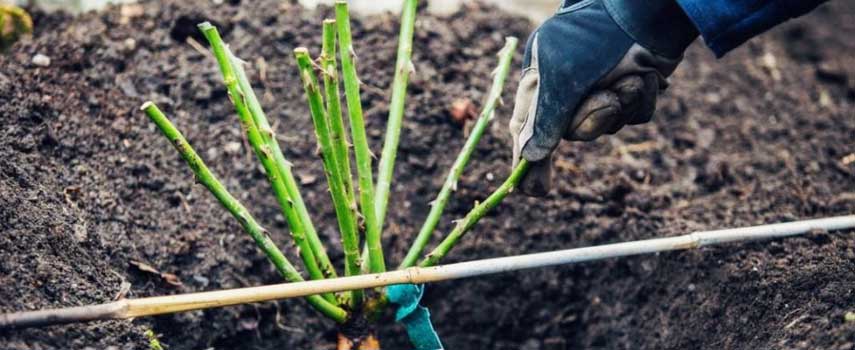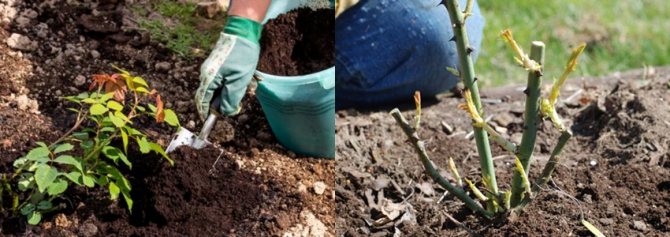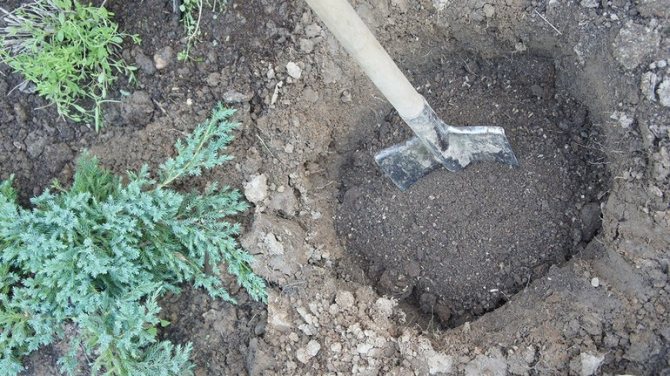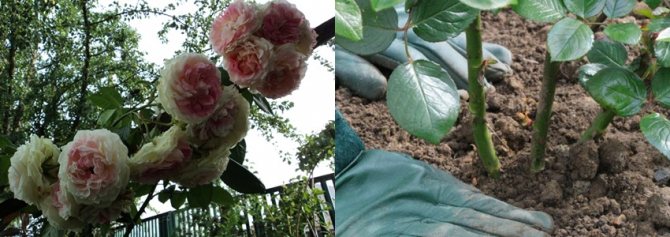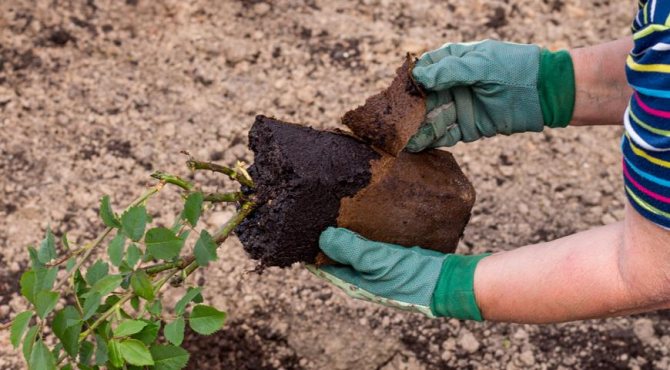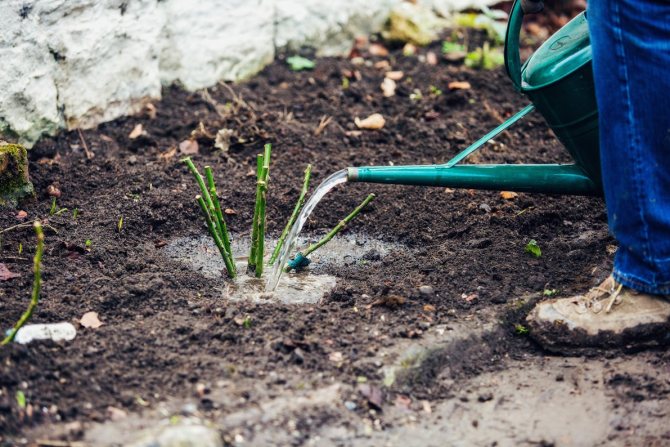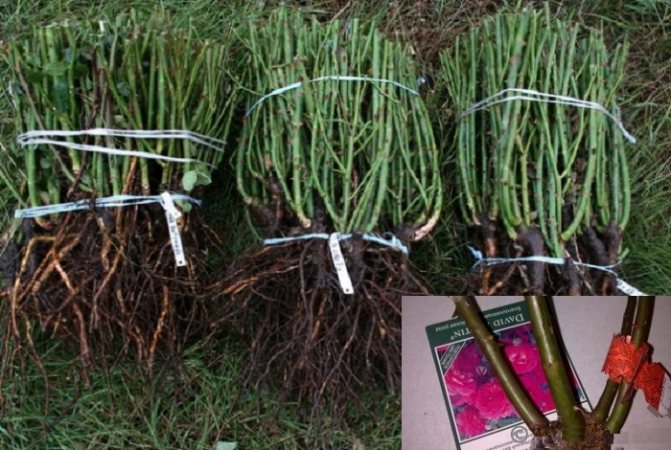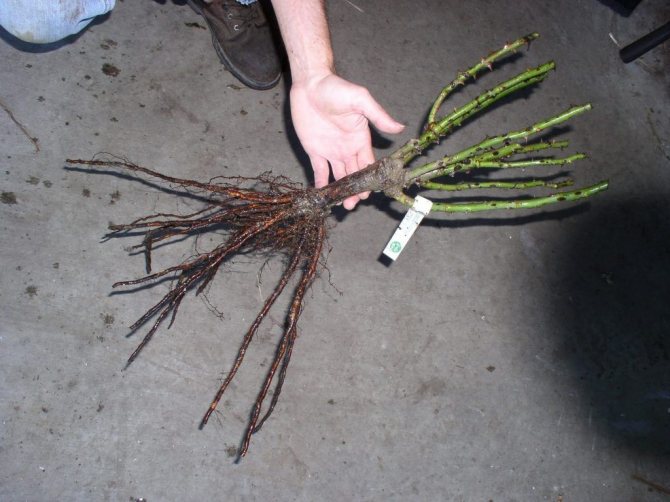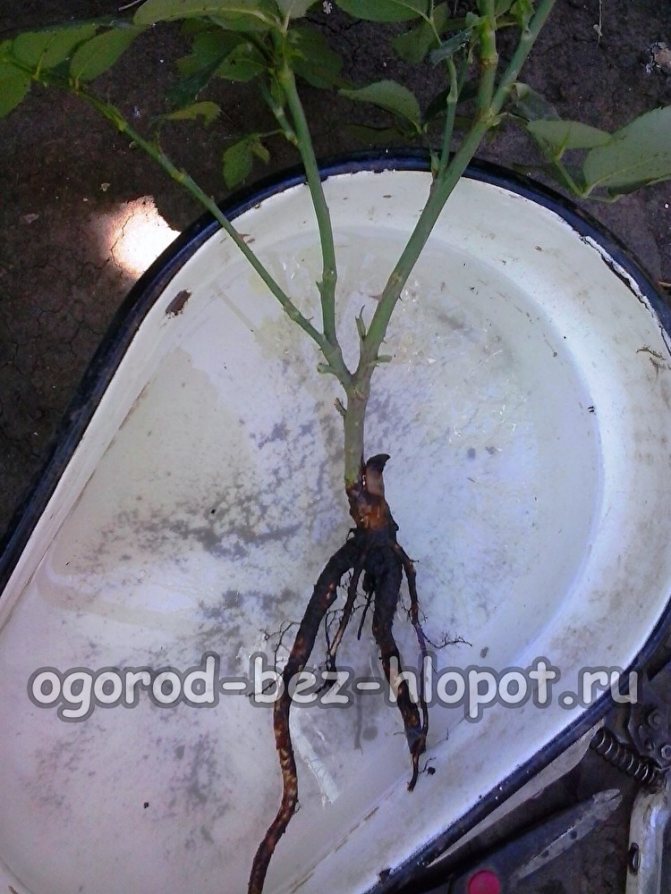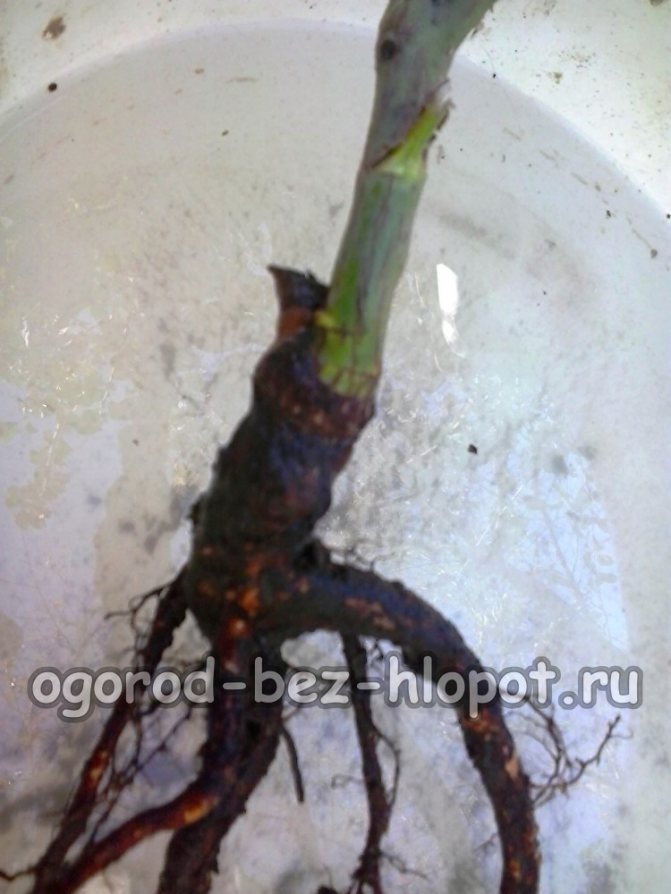Roses are called the queen of flowers for a reason, because she can decorate any area. Therefore, these plants are grown by almost all summer residents and gardeners. However, you need to know the best time and nuances of planting work.
Newbies prefer to plant roses in the spring, since in the warm season it is enough to water and take care of them in a timely manner. Experienced gardeners know that the autumn climate is the best condition for plant rooting and development.
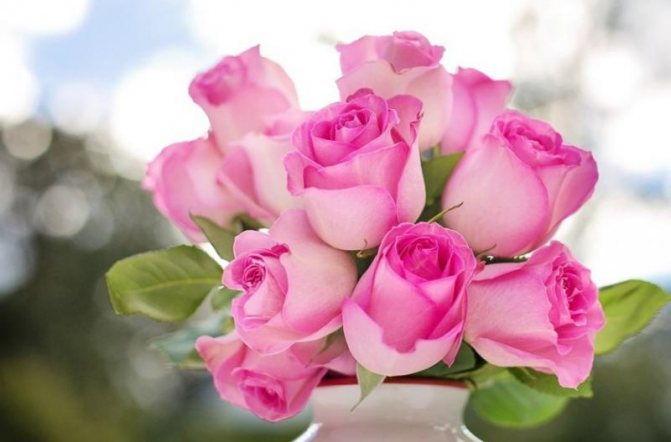
You need to carefully select the planting material. It should only be purchased from trusted breeders. Buy domestic seedlings, as imported counterparts do not always tolerate Russian frosts.
For flowers, we choose a place where there will be partial shade in the middle of the day, and moisture does not linger in the soil. This reduces the risks of developing infectious diseases.
It is also important to take into account the climatic features of the region. For normal rooting, a temperature of 12-17 degrees is required.
When to plant roses in autumn
The optimal period for planting shoots in the soil is September or October. In this case, the rhizome will have time to take root before the first frost.
In the Moscow region, cold weather comes late, but in Siberia and the Urals, subzero temperatures are observed already at the end of autumn. Therefore, the cultivation of these plants in the northern regions of the country requires early planting, as well as the selection of frost-resistant varieties.
Autumn planting of roses has a number of advantages that guarantee a strong and flowering shrub next year:
- During this period, the air humidity is 70-80%, which is 10-20% more than in spring. This indicator increases the rate of plant survival.
- Due to the high rainfall, roses do not need to be watered as often.
- The soil is warmed up, which affects the acclimatization of flowers. Soil temperature is above +14 ° С.
However, there are varieties that can only be grown during spring planting. For example, the very popular unusual Black Prince, Floribunda varieties are planted in May-June. They form standard trees with a spherical crown of various colors. By virtue of such plants can only be taken during spring planting or early autumn, but only in the southern regions.


Planting roses in open ground: nuances and technology
Planting roses can be done in spring or autumn, the main thing is to fully comply with the technology.
Sapling selection
The first stage of growing roses is the choice of material for planting. Flowers can be open or closed rhizomes and can be found in local or overseas nurseries.
Bushes with the first type of roots are planted immediately after purchase, since they are sold during active vegetation. With quality care, they easily take root.
Domestic samples are bought only in the fall and from trusted breeders. Foreign seedlings are carefully examined for bud growth, if any, then the plant is planted in spring.
Pay attention to the flowering period of the specimens, their frost resistance (relevant for the northern regions).
Location
Roses love well-lit areas, the more sun, the more active the buds appear. However, the places where direct rays penetrate are not suitable, since the petals turn pale and burn out, burns occur at the tips.
Shaded areas are strictly prohibited, as flowers tend to the sun, stretch and then weaken.This arrangement increases the likelihood of disease and pest attacks. Places with drafts are not suitable either, since gusts of wind break the stems of the roses.
The best option is the southeastern part of the garden.
Roses love to move away from buildings and other plants. These flowers should not be grown after stone fruit crops, as they severely deplete the soil, especially groundcover.


The soil
Roses prefer light, breathing earth. Water and oxygen are well supplied to the rhizome in chernozems and loams.
Sandstones and sandy stones are not the best option, in summer they are heated by the sun's rays, and in winter they freeze quickly. Such drops affect the rhizome. Professional gardeners correct the situation by adding peat, lime and rotted manure in equal proportions to such soil. When the soil dries quickly, clay is added, spreading it into the planting pit with a layer of 7-8 cm. In mid-September, in preparation for wintering, potassium monophosphate is introduced in the form of a solution.
Planting scheme of various varieties of roses
In September, bush varieties are planted deeper than in the soil of the nursery, since this way the seedlings do not bulge out during cold weather. Climbing varieties deepen even more, due to which additional root processes arise.
- When planting, the roots of the plant are evenly spread in different directions and sprinkled with earth so that it is in close contact with the flower and there are no voids.
- At the bottom of the pit, nutrient soil is poured with a slide, roses are placed on it.
- The hole is covered with soil, rammed and watered.
- Near the base of the shrub, a layer of earth 20 cm high is poured, this protects the roots of the plant from frost.
- Having compacted the soil, it is watered with several buckets of water (per bush).
- After evaporation of moisture, the surface is covered with dry soil, and holes are made around the seedlings for adding water.
The interval between park varieties is from 75 cm to 1 m, since in their adult form they have a spreading crown. The distance between hybrid tea, polyanthus species and floribunda roses is from 30 to 60 cm.
Working with seedlings
Before planting the seedlings, you need to dig a hole about 60 cm deep, the diameter of which should be 40 cm. The next step is to fill the bottom with a drainage mixture consisting of broken brick, expanded clay and pebbles. If the soil is heavy, a layer of clay about 7 cm thick is laid. With sandy soil, fertile soil is poured on top. The planting procedure is carried out in several stages:
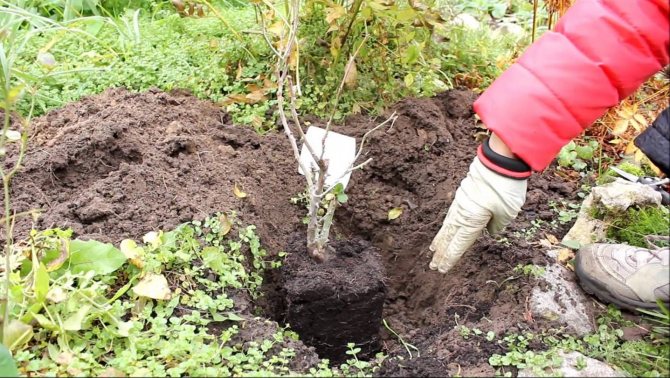

A seedling is placed in the formed hole. Its roots are gently straightened. It is necessary to do this carefully, as careless actions can damage the root system.- The formed space is filled with previously prepared soil, into which it is recommended to add about 2 glasses of ash.
- The soil should be tamped down and watered abundantly with water. In order for the soil to be well saturated, it is recommended to irrigate in several approaches. Typically, water consumption is 1-2 buckets per 1 bush.
- Roots often rise slightly above the surface during winter. This can lead to their death. To eliminate such risks, the seedlings are hilled with a layer of dry peat, the thickness of which should be about 20 cm. This work also allows you to maintain high humidity around the bush. After 2 weeks, the slide is leveled.
Bushes are often planted in groups. The distance between individual bushes should be at least 75-90 cm, otherwise there will not be enough free space for the development of the root system.
When planting some varieties, the distance increases to 1 m, which is associated with the peculiarities of plant growth.
How to properly prune garden blackberries in spring
Transplanting a rose in the fall to another place
Rose is an unpretentious flower that tolerates transplants well. The optimal time is September-October.Spend on a cloudy day or in the evening.
- The bush is carefully dug out, trying not to injure the root system (when diving adult roses, this process becomes more complicated). Minor damage is not terrible, roses heal quickly.
- The shrub is dug in a circle, gradually deepening into the soil. When the taproot is reached, it is chopped off. The plant is taken out of the hole, keeping the clod intact. The flower is moved to a new site in a film, tarpaulin or large bag.
- The well is prepared slightly larger than the root system. Deepen by 5-6 cm. The plant is thoroughly watered, and the hole is mulched.
Tall shrubs are tied to a support because the wind often causes them to bend and bend, making it difficult to align. Pruning is postponed until spring.


Cutting roses in autumn and other methods of propagation
There are several options for breeding roses:
- Cuttings. The advantage of this method is that roses do not produce wild shoots. The stalk is cut close to the leaf bud and then germinated in a growth-promoting preparation. After the appearance of the rhizome, the flower is planted in open ground.
- Budding. On the bark of the stem, next to the ground level, an incision in the shape of the letter T is created, a bud of a cultivar is placed in it and fixed with a film. The operation is not difficult, but experience is needed.
- Using seeds. This method is practically not used, since flowering is expected for several years. The germination rate of this planting material is low.
- Layers. This is how climbing and shrub roses are bred, since they have elongated and strong stems. In the lower part of the shoot, an incision is made about 8 cm long, a match is placed in it. This part of the trunk is placed in the ground and attached, the free tip is connected to a peg. The rooted plant is separated from the mother shrub.
Burrito method
In America, a new method was developed - "burrito". This is a traditional Mexican dish with a filling, the preparation of which resembles this breeding process.
- In autumn, cuttings are cut with a length of 15-20 cm. The strongest stems are left. Cut from the bottom under the bud, and above - between the shoots. They are cleaned and selected the strongest, not affected by diseases and pests.
- The cuttings are wrapped in newspaper. In this case, the scrap is the filling, and the paper is the "burrito".
- The resulting roll is moistened and packed in polyethylene. Store at about +18 ° C.
- Air once every 7 days, check for rotting. If mold appears, it is better to throw out the workpiece.
- After about 28-30 days, roots should form at the cut sites. Then the cuttings are planted in open ground.
Mr. Summer resident warns: mistakes during planting roses
When planting roses in the autumn season, miscalculations are possible:
- For rooting, a flower is planted in peat. The rose rots and dies. The solution is planting in loam saturated with minerals.
- When growing, the roots are bent upward. Slow growth and development of the plant is observed. Prevention - after planting, the location of the root system is monitored.
- Excessive deepening of grafting into the soil. The norm is 5 cm, otherwise the flowers wither and die.


Benefits
Supporters of growing roses from cuttings highlight the main advantages of this method used in the fall:
- The absence of growth without varietal characteristics after propagation by cuttings, which simplifies the care of the flower in the future.
- Such specimens are considered more frost-resistant, since even after the complete freezing of all aboveground organs, they restore shoots from dormant buds located on the main roots. Recovery in such cases occurs very quickly, literally in the first month of the growing season.
- Planting material for autumn cuttings does not need to be bought, so this propagation method is available to everyone.
- Over the summer, the shoots accumulate in their structure a greater amount of nutrients that the bush needs for a successful wintering, therefore, their rooting potential is an order of magnitude higher than that of the cut in other seasons.
The method is so simple that no special skills are required to apply it, so it is available even for novice gardeners who need to increase the number of rose bushes on the site in one season.
Fertilizing roses
In the spring, fertilizers are applied before the active growth of the plant, when a positive temperature is established. Possible options:
- add half a bucket of mullein around the bush;
- sprinkle 20 g of ammonium nitrate or urea on the moistened soil, watered;
- use special fertilizers for roses, be sure to use nitrogen-containing;
- mulch with compost.
In the summer, for abundant flowering, roses are fed several times with organic solutions (mullein, chicken droppings, ash), by spraying on flowers in the evening.
Fall dressings should replenish nutrients in the soil depleted after flowering and prepare the plant for winter:
- watered with phosphorus-potassium fertilizers (25 g of superphosphate, 10 g of potassium per 10 l of water);
- in September, nitrogen substances are excluded, since they promote the growth of young shoots, which is not necessary when preparing a rose for winter:
- when a cold snap sets in, the bushes mulch.
Selection and preparation of a seedling


How to choose planting material
Choose a seedling carefully before planting. Consider the following features:
- it is desirable that the roots are developed, without spots, traces of decay, overdried areas;
- healthy seedling intensely green, with gloss, sharp thorns, 3-4 developed shoots;
- if the rose is in a pot, pay attention to how tightly the earth adheres to the walls of the container; if there are voids, refuse to buy planting material.
Roses with an open root system should be prepared for planting in a special way. Use the following instruction:
- Place the roots in a bucket of water for 24 hours.
- Remove the leaves.
- Shorten the shoots to 30 cm.
- Trim the roots to 25 cm.
- Remove rotten areas, buds located below the graft.
- For prophylaxis against a number of diseases, lower the seedling for 1-2 hours in a 3% solution of ferrous sulfate or Fundazol (10 g per 2 liters of water), dip the roots in a mess of 2 parts of clay and 1 part of cow dung.
Preparing roses for winter
Roses are overly susceptible to cold weather, so they require some protection for the winter.
Pruning
Correct pruning makes it easier for the rose to withstand the cold. The lower foliage and shoots are the first to suffer from diseases, so they are completely removed already in mid-September. The rest of the steps depend on the variety of colors.
Weaving varieties are pinched at the point of growth, and bush and species are cut off under the base. The procedure is performed 1-2 weeks before the shelter, leaving only 3-5 stems.
Shelter for the winter
At a temperature of + 5 ... + 7 ° C, the shrubs are covered with spruce branches and wire frames are mounted under it, the shape is a semicircle. The building is covered with a film or roofing felt.
Suitable height is 40-50 cm. Dimensions are related to the number of seedlings. At a temperature of -10 ° C, the film is slightly pressed against the soil.
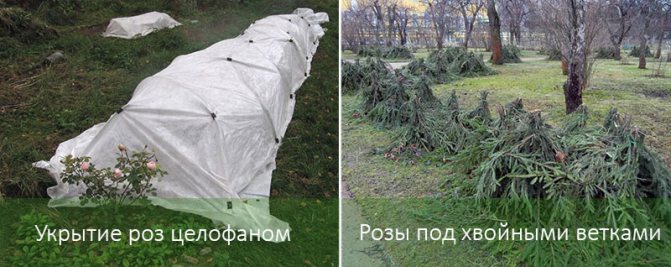

Young standard roses are carefully bent to the soil and pinned with wire. The grafting site is covered with soil or compost a little. Mature bushes can be left without bending. They are covered with a bag of dry leaves.


Climbing roses are neatly separated from the support along which they curled, placed on spruce branches and insulated.
In the spring, the structure is disassembled only after a little airing so that the flowers do not get burned.
Preparing for the winter properly will help maintain healthy, beautiful plants.
Further care
Autumn planting is associated with constant air temperature control. This is one of the most important aspects of caring for roses after planting. Other features include the following:
- At an air temperature of 5-7 ° C, the plant is covered with spruce branches.You can make semicircular wire frames that are covered with roofing felt or polyethylene. The optimum height of the structure is 40-50 cm. The dimensions of the structure depend on how many seedlings are planted at the same time.
- If the ambient temperature is about 10 °, then the film is sprinkled a little with soil around the edges. This eliminates the possibility of cold air getting under the shelter.
- In spring, it is recommended to remove the protective structure not immediately. This is due to the fact that a sharp exposure to high temperatures and sunlight can provoke a burn of the leaves of roses.
Even an inexperienced gardener will be able to grow beautiful roses on his site with a late planting. To do this, you just need to follow the recommendations for planting and further care.
There are no difficulties in planting roses in the fall, and with the right approach, in a few months the plants will delight the owner with beautiful flowers.
Features of caring for guzmania at home
Mr. Summer resident advises: winter-hardy varieties of roses for the middle lane
For breeding in the middle lane (Moscow region), the following varieties of roses are perfect:
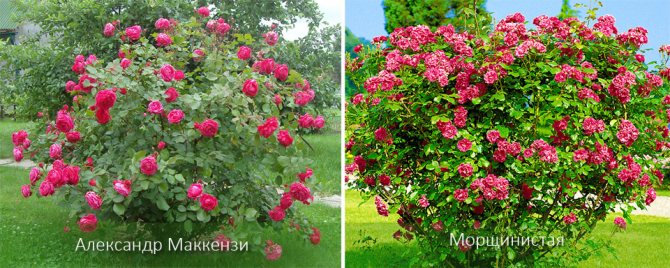

| Variety | Variety | Description | Flowers |
| D. Austin | Charles Austin. | Shrub plant, height up to 150 cm. Smell - fruity. | Inflorescences are racemose. The buds are pale orange. |
| Princess Alexandra of Kent. | Rounded bush, grows up to 90 cm, width - 60 cm. Smell - lemon-currant. | Large, terry. Diameter about 12 cm. Color - pink. | |
| Crown Princess Margaret. | A climbing flower, reaching a height of 2.5 m. The stems are in the shape of an arc, therefore, a support is used. The flowering period is from June to mid-autumn. | Apricot. | |
| Park | Wrinkled. | A vigorous shrub, the trunk reaches 150 cm in height. There are large thorns on the shoots. Frost-resistant variety, feels comfortable at temperatures down to -40 ° C. Petals are widely used to make jam. | Semi-double, about 12 cm in diameter. |
| Alexander Mackenzie. | Shrub with a height of up to 200 cm, width - up to 150 cm. There are thorns on the shoots. | Terry. The color is crimson red. | |
| William Buffin. | Homeland - Canada. Shrub height up to 3 m, width - about 2 m. It has good immunity to fungal pathologies, grown in the shade. | Semi-double, deep pink, the core is white. | |
| Frost-resistant (can winter without shelter) | Albe. | Shrub plant, has strong erect shoots, height up to 2.8 m. Duration of flowering - a month. | Terry, snow-white. |
| Shrubs. | Semi-plaited variety of shrub, up to 3 m high. | Light pink. | |
| Agness. | Grown on any soil, including sand. | Creamy yellow. | |
| Tea-hybrid | Gloria Day. | Shrub plant, trunk reaches 1 m. | Large, terry. The color is deep yellow, has a pink border. |
| Blue moon | Shrub reaching 90 cm. Susceptible to powdery mildew attacks. | Purple, lush. | |
| Double Delight. | Shrub, grows up to 1 m. It is immune to fungal diseases. | Contrasting, deep pink. | |
| Nicole. | Two-color cut-type variety. | Inside - bright red, outside - white. | |
| Paradise. | It grows up to 1 m. There are many thorns on the shoots. High immunity to fungal diseases. In winter, they must be covered, otherwise the plant will die. | White and red. |


All varieties of roses will decorate any corner of the garden, giving it a cozy and well-groomed look. It is important not to neglect the recommendations for planting and caring for these beautiful plants.


